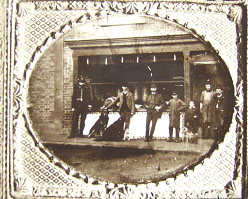Shopping in Hampton
Shopping moves west towards the station

The road plan of Hampton was established hundreds of years ago. Both Thames Street and High Street were well defined by the 17th century and probably long before that. Modern Station Road, known variously as 'Road to Hanworth', 'Road to Four Hills', 'Road to Warfield', Smoaky Lane and New Street also existed then. Until around the turn of the 19th century, however, the roads were narrow, unmetalled, uncambered, ill-drained and in many places bordered by dangerous ditches.
In 1800 the Register of Alehouse Keepers listed 10 public houses in Hampton of which 3 were in Thames Street, 5 in High Street and 2 in modern Station Road. Four of these public houses are still in business today.

Thames Street was the original main shopping street but High Street was also important. Station Road developed later but the number of shops had surpassed those in each of the other two streets by 1900. By 1914 Station Road had more shops than Thames Street and High Street combined. By the 1930s the shops in the Ashley Road/Milton Road/Station Approach/Wensleydale Road area had been built and were also more numerous than either Thames Street or High Street. The growth of Hampton to the north and west, combined with increased traffic congestion, saw a decline in the number of shops in Thames Street, particularly in the 1950s and 1960s. There were few shops left there by the 1970s and currently a second-hand bookshop is the sole survivor. Apart from the important 16th century Red Lion coaching inn (formerly The Shipp) at the junction with Thames Street, High Street also contained a number of shops and businesses at its southern end.

These included The Jolly Gardeners (closed 1955) and The Jolly Coopers, now nearly 300 years old. The Duke's Head (formerly Maidenhead), of a similar age, still trades at the northern end of High Street. Another very old public house, The White Hart (formerly The Six Bells), was converted into apartments in 2005.
Station Road was the name given to part of New Street in about 1900. In the 19th century it was bordered by a number of large houses with high walls Gradually as the larger estates were developed more shops were built. In 1876 there were 8 shops, 12 in 1890, 23 in 1895, 35 in 1914 and 42 by 1931: almost the same number as today. It was also a very narrow road and has been widened at various points.
The last shopping area to develop was the conjunction of roads at Ashley Road/Milton Road/Station Approach /Wensleydale Road. As the north and west of Hampton developed there was much more demand for shops that were more “central” to that area and by 1930 there were 31 shops here.



